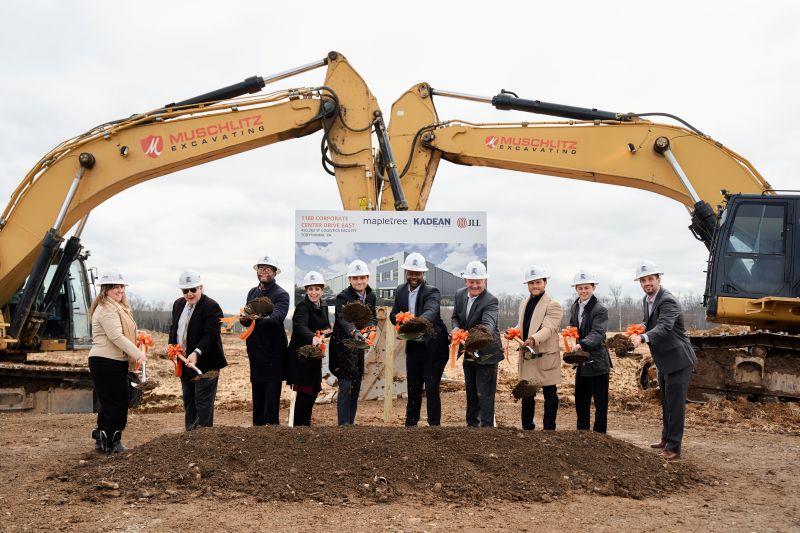AIIB and GIZ to Deepen Collaboration on Green Infrastructure Investment – Asian Infrastructure Investment Bank (AIIB)

Strategic Partnership Report: AIIB and GIZ Collaboration for Sustainable Development Goals
Executive Summary
The Asian Infrastructure Investment Bank (AIIB) and the Deutsche Gesellschaft für Internationale Zusammenarbeit (GIZ) GmbH have formalized a strategic collaboration through a letter of intent, establishing a three-year roadmap for joint action. This partnership is designed to accelerate progress toward the Sustainable Development Goals (SDGs) by combining AIIB’s financing capabilities with GIZ’s technical and capacity-building expertise. The collaboration will focus on identifying, preparing, and implementing sustainable infrastructure projects and climate programs that deliver scalable and impactful solutions in member and partner countries, directly addressing the 2030 Agenda for Sustainable Development.
Key Areas of Cooperation and SDG Alignment
The partnership outlines four priority areas of cooperation, each intrinsically linked to specific Sustainable Development Goals:
- Green, Climate, and Biodiversity Infrastructure: This area directly targets SDG 13 (Climate Action), SDG 14 (Life Below Water), and SDG 15 (Life on Land) by promoting environmentally sound projects. It also contributes to SDG 7 (Affordable and Clean Energy) and SDG 11 (Sustainable Cities and Communities).
- Connectivity and Regional Cooperation: This focus supports SDG 9 (Industry, Innovation, and Infrastructure) by enhancing regional connectivity and fosters global collaboration as outlined in SDG 17 (Partnerships for the Goals).
- Technology-Enabled and Social Infrastructure: By investing in these sectors, the partnership will advance SDG 3 (Good Health and Well-being), SDG 4 (Quality Education), and further strengthen progress on SDG 9 and SDG 11.
- Private-Capital Mobilization: This initiative is crucial for financing the SDGs and directly aligns with the objectives of SDG 17, which emphasizes the need for robust financial partnerships to achieve sustainable development.
Strategic Objectives
The collaboration aims to achieve several strategic objectives in pursuit of the SDGs:
- Joint Project Implementation: To identify, prepare, and implement eligible sustainable infrastructure projects and climate programs that are green, inclusive, and resilient, ensuring alignment with national development needs and the global SDG framework.
- Resource Synergy: To leverage the collective resources of both institutions by combining GIZ’s technical cooperation services with AIIB’s strategic financing. This includes the joint mobilization of concessional resources to close the global infrastructure finance gap, a key enabler for SDG 9 and SDG 17.
- Knowledge and Capacity Enhancement: To facilitate the sharing of knowledge and best practices, alongside opportunities for staff exchanges and institutional learning, thereby strengthening the capacity of all stakeholders to implement SDG-aligned projects effectively.
- Advancing Inclusive Development: To uphold the principle of “leaving no one behind” by ensuring that all joint initiatives promote inclusive and sustainable development, directly contributing to SDG 1 (No Poverty) and SDG 10 (Reduced Inequalities).
Institutional Profiles in the Context of Sustainable Development
Asian Infrastructure Investment Bank (AIIB)
AIIB is a multilateral development bank with a core mission to finance “Infrastructure for Tomorrow,” placing sustainability at the center of its operations. With 110 approved members and a capitalization of USD100 billion, AIIB is dedicated to mobilizing capital for infrastructure and other productive sectors that foster sustainable economic development and support the achievement of the SDGs across Asia and beyond.
Deutsche Gesellschaft für Internationale Zusammenarbeit (GIZ) GmbH
GIZ is a global service provider specializing in international cooperation for sustainable development. With extensive experience in areas such as economic development, energy, and the environment, GIZ supports public and private sector clients in approximately 120 countries. As a public-benefit federal enterprise, GIZ works with partners to develop effective solutions that directly contribute to achieving the objectives of the 2030 Agenda for Sustainable Development.
1. Which SDGs are addressed or connected to the issues highlighted in the article?
The article highlights a strategic collaboration between the Asian Infrastructure Investment Bank (AIIB) and the Deutsche Gesellschaft für Internationale Zusammenarbeit (GIZ) focused on financing and implementing sustainable infrastructure. This partnership directly connects to several Sustainable Development Goals (SDGs) centered around infrastructure, economic growth, climate action, and global partnerships.
- SDG 7: Affordable and Clean Energy – The focus on “green infrastructure” implies investment in renewable energy sources and clean energy technology.
- SDG 8: Decent Work and Economic Growth – The article mentions fostering “sustainable economic development” through infrastructure investment, which is a key driver of economic growth and productivity.
- SDG 9: Industry, Innovation, and Infrastructure – This is the most central SDG, as the entire article revolves around developing “sustainable infrastructure,” enhancing “regional connectivity,” and financing “Infrastructure for Tomorrow.”
- SDG 10: Reduced Inequalities – The commitment to “inclusive” development and a vision that “leaves no one behind” directly addresses the core principle of reducing inequalities.
- SDG 11: Sustainable Cities and Communities – The development of green, resilient, and technology-enabled infrastructure is fundamental to creating sustainable urban and regional environments.
- SDG 13: Climate Action – The partnership explicitly prioritizes “climate programs” and “climate infrastructure,” demonstrating a direct commitment to addressing climate change.
- SDG 15: Life on Land – The mention of “biodiversity infrastructure” connects the partnership’s goals to the protection and sustainable management of terrestrial ecosystems.
- SDG 17: Partnerships for the Goals – The article is fundamentally about this SDG, describing a partnership that combines financing (AIIB) with technical cooperation (GIZ) to achieve shared sustainable development objectives and mobilize capital.
2. What specific targets under those SDGs can be identified based on the article’s content?
Based on the priorities and actions described in the article, several specific SDG targets can be identified:
-
SDG 9: Industry, Innovation, and Infrastructure
- Target 9.1: “Develop quality, reliable, sustainable and resilient infrastructure, including regional and transborder infrastructure, to support economic development and human well-being.” The article’s core mission is to “jointly identify, prepare and implement eligible sustainable infrastructure projects” and “enhance regional connectivity.”
- Target 9.a: “Facilitate sustainable and resilient infrastructure development in developing countries through enhanced financial, technological and technical support.” The partnership model directly reflects this, combining AIIB’s “financing capabilities” with GIZ’s “technical and capacity-building services.”
-
SDG 17: Partnerships for the Goals
- Target 17.3: “Mobilize additional financial resources for developing countries from multiple sources.” The article explicitly lists “private-capital mobilization” as a priority area of cooperation.
- Target 17.9: “Enhance international support for implementing effective and targeted capacity-building in developing countries to support national plans to implement all the Sustainable Development Goals.” This is a primary function of GIZ, which provides “technical and capacity-building services” within the partnership.
- Target 17.16: “Enhance the global partnership for sustainable development, complemented by multi-stakeholder partnerships that mobilize and share knowledge, expertise, technology and financial resources.” The agreement between AIIB and GIZ is a direct example of such a partnership, designed to “share knowledge and best practices.”
-
SDG 13: Climate Action
- Target 13.a: “Implement the commitment undertaken by developed-country parties… to a goal of mobilizing jointly $100 billion annually… to address the needs of developing countries.” The partnership aims to “mobilize concessional resources for joint initiatives,” including “climate programs,” contributing to this global financing goal.
-
SDG 7: Affordable and Clean Energy
- Target 7.a: “By 2030, enhance international cooperation to facilitate access to clean energy research and technology… and promote investment in energy infrastructure and clean energy technology.” The focus on “green infrastructure” directly supports investment in clean energy infrastructure.
3. Are there any indicators mentioned or implied in the article that can be used to measure progress towards the identified targets?
The article does not mention official SDG indicators with specific codes, but it implies several metrics that can be used to measure the success and progress of the AIIB-GIZ partnership in relation to the identified targets:
- Volume of mobilized capital: The article emphasizes “private-capital mobilization” and AIIB’s role in financing. A key indicator would be the total amount of financing (public, private, and concessional) directed towards the joint projects. This relates to indicators for Target 17.3 and 13.a.
- Number and scale of implemented projects: Progress can be measured by the number of “eligible sustainable infrastructure projects and climate programs” that are jointly identified and implemented. This would serve as a proxy indicator for progress towards Target 9.1.
- Investment in specific infrastructure types: The amount of investment channeled specifically into “green, climate and biodiversity infrastructure” and “social infrastructure” can be tracked to measure progress in these priority areas, relating to SDGs 7, 13, and 15.
- Establishment of formal agreements: The signing of the “letter of intent” itself is an indicator of progress towards Target 17.16, as it formalizes the partnership and sets a “roadmap for joint action.”
- Knowledge sharing and capacity-building activities: The number of “staff exchanges,” joint knowledge-sharing events, and “capacity-building services” delivered by GIZ would be a direct measure of progress on Target 17.9.
4. Create a table with three columns titled ‘SDGs, Targets and Indicators” to present the findings from analyzing the article.
| SDGs | Targets | Indicators (Mentioned or Implied in the Article) |
|---|---|---|
| SDG 9: Industry, Innovation, and Infrastructure | 9.1: Develop quality, reliable, sustainable and resilient infrastructure. 9.a: Facilitate sustainable infrastructure development through financial and technical support. |
Number and scale of implemented sustainable infrastructure projects; Amount of investment in regional connectivity and technology-enabled infrastructure. |
| SDG 17: Partnerships for the Goals | 17.3: Mobilize additional financial resources. 17.9: Enhance international support for capacity-building. 17.16: Enhance the global partnership for sustainable development. |
Volume of private and concessional capital mobilized; Number of capacity-building services delivered; Formalization of the partnership through the signed letter of intent; Number of knowledge-sharing initiatives and staff exchanges. |
| SDG 13: Climate Action | 13.a: Mobilize financial resources for climate action in developing countries. | Amount of financing mobilized for “climate programs” and “climate infrastructure.” |
| SDG 7: Affordable and Clean Energy | 7.a: Enhance international cooperation and investment in clean energy infrastructure. | Total investment in “green infrastructure” projects. |
| SDG 8: Decent Work and Economic Growth | 8.1: Sustain per capita economic growth. | Contribution of infrastructure projects to “sustainable economic development” in partner countries. |
| SDG 10: Reduced Inequalities | General principle of “leaving no one behind.” | Implementation of projects that are “inclusive” and benefit underserved communities. |
Source: aiib.org

What is Your Reaction?
 Like
0
Like
0
 Dislike
0
Dislike
0
 Love
0
Love
0
 Funny
0
Funny
0
 Angry
0
Angry
0
 Sad
0
Sad
0
 Wow
0
Wow
0




















































.jpg.webp?itok=0ZsAnae9#)


























